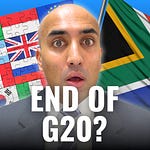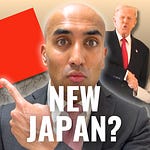A game of “who was first” is playing out between Biden and Trump over creating an American sovereign wealth fund.
The concept of “sovereign wealth fund” stems from the Middle East, when Kuwait created the “Kuwait Investment Authority” in 1953 to invest extra revenue from oil sales.
Since then, mainly energy-rich nations, from Norway to Australia, have set up sovereign wealth funds to drive foreign investment. In recent times, non-energy economies have also jumped onto the bandwagon, like the Philippines, which established the Maharlika Investment Corporation with $2.3 billion in funding. Sovereign wealth funds don’t just have to invest in other nations, they can invest at home, as Maharlika focuses on developing two million hectares of untapped state land in the Philippines.
For much of the world, establishing a sovereign wealth fund was a smart way to slice energy multiple ways. Energy, like oil, was a source of revenue. But it needn’t stop there. That same revenue could then be reinvested, domestically or globally, expanding the nation’s influence.
However, a sovereign wealth fund would serve a very different purpose for the US.
It would be established to ensure America can compete in the 21st century, with a particular focus on China and protecting American long-term national interests.
The massive Chinese geoeconomic footprint, where over 140 countries are part of the Belt and Road Initiative (BRI), the Chinese multi-trillion plan to reroute global trade through Chinese-controlled corridors, represents a Goliath-like trend that America must reverse or match to maintain its place in the world.
But to do this, the US must unleash hundreds of billions of dollars, potentially regularly, at home and abroad, from funding critical sectors like AI or clean energy to supercharging development in emerging markets.
The Chinese have multiple geoeconomic tools to drive this. The US has none. Except for specific legislation, like CHIPS Act or IRA, there is no core vehicle to drive strategic American investments.
This is a massive vulnerability and shortfall for the US - and has been for decades.
Creating a US sovereign wealth fund is also about Washington relying less on what its companies do regarding geopolitics. If US firms resist leaving China or establishing alternate supply chains in other countries, then a US sovereign wealth fund might do the heavy lifting.
Through a US sovereign wealth fund, Washington could take the first step in creating a new foundation that its companies can stand on, insulated from geopolitics.
Creating a US sovereign wealth fund would be a historic move. It would be about securing America’s future.
But as America moves in this direction, it could change how the US engages with many other nations. Of the many geopolitical balls up in the air, perhaps the biggest is how a sovereign wealth fund could redraw the map of American power in the world.
TRUSTING AMERICA
The moment a US sovereign wealth fund is launched, governments will be tested: how much do they trust America?
It is one thing if Apple or JP Morgan invest in a local market, as American businesses. It is another thing if the US government is investing as part of an investment project designed in Washington.
This could scare many countries, who see a clear difference between US business investment and US government investment - even if the latter involves American companies.
Unlike Chinese investment which has been state-backed or state-driven from the beginning, US investment has not functioned this way. Except for specific deals, the US government was never in the driver’s seat.
Soon it could be. And, this will force many governments to decide whether they are comfortable having a direct, public presence of Washington within their borders and economies.
Many governments might not trust America’s capital injections. What does America want?
And countries might feel America’s fund could jeopardize their own interests.
If Vietnam accepts $2 billion from America’s state fund to shift away from coal, what is Hanoi signaling to China? If Indonesia accepts $3.5 billion from America’s state fund to develop its local nickel industry, will Jakarta lose projects from Russia, China, or India?
The same questions the West has been pressuring countries to ask of China might now be directed at America, with its sovereign wealth fund.
This will all be a litmus test of how much the world trusts America.
Some nations, like Argentina or Poland, are likely to jump at the idea of an American sovereign wealth fund entering their nations.
But others, like Malaysia or Germany, might take a critical stance, equating America’s fund with the American government, sparking fears around sovereignty and national security.
CONDITIONS, POLITICS
Currently, the largest sovereign wealth fund in the world is the Government Pension Fund of Norway, which has assets over $1.75 trillion.
Like other sovereign funds, Norway’s fund has taken an ideological stance at times on investments, for instance, proposing to stop investing in companies that are only focused on fossil fuels. Recently, however, the Norwegian fund has gone beyond this, introducing “guidelines” for the use of AI in companies the fund invests in, and, separately, shutting down its only office in China.
Like Norway, the US sovereign wealth fund, which has the potential to become one of the world’s largest, will have to make certain decisions. Will America’s fund be a purely financial endeavor focused on securing American economic security? Or, will geopolitics be built into the investment model?
If the US takes a more explicit route, imposing geopolitics on investments, it could split the world.
The conditions America sets, from forcing companies it invests in to reject financing from American adversaries to requiring companies to adopt US technology in their operations, would mean America is packaging geopolitics and cash into a single offering, forcing everybody to pick sides.
There are also the geographies America’s fund could enter that are caught in the middle of geopolitics.
Just as Norway’s state fund shut down its only China office, will America’s fund ever open a China office? And, in many geographies aligned with American adversaries, the US sovereign wealth fund will present capitals with new headaches.
Tomorrow, Azerbaijan, aligned with Russia, could be put in a challenging position if America’s sovereign wealth fund knocks on its door. Baku might want the cash; Moscow likely won’t. Or, if America’s sovereign wealth fund works in tandem with Washington, retracting sanctions on Venezuela, in exchange for new American FDI (from the sovereign wealth fund), it is a move sure to make Russia and China sit up.
Even if America chooses the other path, of making its sovereign wealth fund a purely financial endeavor, geopolitics will still come into the picture.
The US sovereign wealth fund may want to establish a new set of strategic reserves, like a strategic chip reserve or a strategic lithium reserve, to insulate the US from a volatile world stage.
These reserves would mimic America’s Strategic Petroleum Reserve (SPR), which was designed to be the world’s largest supply of emergency oil, and was formed out of a separate geopolitical crisis (the Arab oil embargo against the US).
Except where will America go to stockpile these goods?
From clashing with other nations to secure chips to purchasing lithium from China, a paradox as the US purchases the lithium to shield itself from China, America’s state fund could take risky steps to build reserves.
The steps the US takes to procure items for its reserves, funded by its sovereign wealth fund, could put America on a collision course with other global stakeholders, from governments to businesses.
Whatever path America takes with its fund, geopolitics will play a central role.
FUNDING QUESTIONS
A big unknown is how a US sovereign wealth fund would be funded. In other countries, from energy exporters to emerging markets, there are only a few sources to draw capital from.
In the US, there are many sources. But, considering the US is creating a fund likely with geoeconomics in mind, like battling China, it could result in unorthodox funding strategies.
Once the size of the fund is identified (i.e. $250 billion), the US could draw cash from traditional sectors like energy. In 2023, the US became the world’s largest exporter of liquified natural gas (LNG), overtaking the previous leaders Qatar and Australia. The US could take profits from LNG exports and dump them into its sovereign wealth fund.
This creates a new incentive for American energy independence.
However, this also faces obstacles. Unlike Middle Eastern or Scandinavian nations which established their funds at a time when the price of energy was stable and rising, it is not the same case today. While the US is the largest LNG exporter in 2024, LNG export prices for the first half of the year are down 25%, in part because Europe is deriving more energy from renewable sources.
Depending solely on profits from US energy sectors might not be sustainable.
This could result in Washington looking at other ideas.
One of them could be pushing large American companies to invest in the fund.
From tech to automotive to finance, America’s corporate might be incentivized to redirect portions of their profits into a US sovereign wealth fund. And, the US government could offer these companies a tax break, that over time, might add up to their initial contribution.
It would be positioned as in the “national interest.”
However, this may scare some companies, who worry their neutrality will be shattered in the eyes of other governments if they contribute to the American sovereign wealth fund that is taking geopolitical steps. Or, if the fund takes steps that jeopardizes another country’s interests, the companies who contributed to the fund could be targeted or put under the spotlight (by other nations).
Another funding strategy could be to redirect levies collected from tariffs into the fund’s coffers.
The current and future tariffs America imposes, especially if Trump is reelected, measuring in the tens of billions of dollars, could quickly become the starting capital for America’s sovereign wealth fund.
Of course, redirecting tariff levies into a sovereign wealth fund could anger the world.
Other governments might view this as America profiting on the back of unfair trade practices, creating a new set of trade disputes between America and other nations.
Conclusion
When an asteroid smashes into an ocean, it generates shockwaves the world feels.
That is what is at stake with a US sovereign wealth fund. The largest economy in the world could create a fund on a scale that unleashes historic global change. And this would all be driven by a new fight on the world stage around who wears the crown.
At the center of establishing a sovereign wealth fund is a growing realization in US geostrategic circles that America’s dominance in the world has severely eroded. And, the idea that the US will call the shots in the future is truly no longer guaranteed, no matter who wins an election or what new billion-dollar unicorn forms.
The ground of the world has shifted so significantly and so quickly, that America must now move in bold and transformational ways to secure its place and position. Queue a sovereign wealth fund.
A sovereign wealth fund is a new kind of geoeconomics, or geofinance, aimed largely at the emergence of China as an economic superpower. From the BRI to the Asian Infrastructure Investment Bank (AIIB) to the catalogue of state-owned or state-backed companies, China has leveraged government-directed investments to build an empire-like footprint.
And America didn’t see it coming.
Now, the US needs its own instruments, under its own thumb that can direct the resources, technology, and ingenuity of America into a world bruised by crises and competition.
However, to take on China, to champion democracy and liberty, a US sovereign wealth fund means the US state will be playing an ever greater role in the affairs of the American economy, like in China.
Perhaps, that is the price that has to be paid in today’s geopolitics. To compete, nations have to emulate parts of the nation they are competing against.
Beyond being an investment vehicle or a new geoeconomic play, a US sovereign wealth fund reflects a “new America.”
One who accepts that to remain the center of the world, the government has to be in control of America’s global footprint.
Only in this kind of setup, where Washington leads and the rest of the country follows, does America have a chance of ensuring that in the near future, the grand chessboard is not stacked against it.
-Abishur
Want to republish this insight? Let’s talk: abishur@mrgeopolitics.com
If you liked this insight, why not invite your team?
If there is somebody you feel would benefit from Mr. Geopolitics, gift them a subscription.












